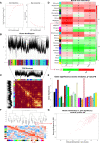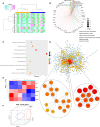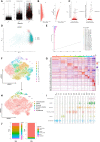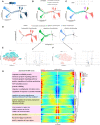Revealing the Key MSCs Niches and Pathogenic Genes in Influencing CEP Homeostasis: A Conjoint Analysis of Single-Cell and WGCNA
- PMID: 35833124
- PMCID: PMC9271696
- DOI: 10.3389/fimmu.2022.933721
Revealing the Key MSCs Niches and Pathogenic Genes in Influencing CEP Homeostasis: A Conjoint Analysis of Single-Cell and WGCNA
Abstract
Degenerative disc disease (DDD), a major contributor to discogenic pain, which is mainly resulted from the dysfunction of nucleus pulposus (NP), annulus fibrosis (AF) and cartilage endplate (CEP) cells. Genetic and cellular components alterations in CEP may influence disc homeostasis, while few single-cell RNA sequencing (scRNA-seq) report in CEP makes it a challenge to evaluate cellular heterogeneity in CEP. Here, this study conducted a first conjoint analysis of weighted gene co-expression network analysis (WGCNA) and scRNA-seq in CEP, systematically analyzed the interested module, immune infiltration situation, and cell niches in CEP. WGCNA and protein-protein interaction (PPI) network determined a group of gene signatures responsible for degenerative CEP, including BRD4, RAF1, ANGPT1, CHD7 and NOP56; differentially immune analysis elucidated that CD4+ T cells, NK cells and dendritic cells were highly activated in degenerative CEP; then single-cell resolution transcriptomic landscape further identified several mesenchymal stem cells and other cellular components focused on human CEP, which illuminated niche atlas of different cell subpopulations: 8 populations were identified by distinct molecular signatures. Among which, NP progenitor/mesenchymal stem cells (NPMSC), also served as multipotent stem cells in CEP, exhibited regenerative and therapeutic potentials in promoting bone repair and maintaining bone homeostasis through SPP1, NRP1-related cascade reactions; regulatory and effector mesenchymal chondrocytes could be further classified into 2 different subtypes, and each subtype behaved potential opposite effects in maintaining cartilage homeostasis; next, the potential functional differences of each mesenchymal stem cell populations and the possible interactions with different cell types analysis revealed that JAG1, SPP1, MIF and PDGF etc. generated by different cells could regulate the CEP homeostasis by bone formation or angiogenesis, which could be served as novel therapeutic targets for degenerative CEP. In brief, this study mainly revealed the mesenchymal stem cells populations complexity and phenotypic characteristics in CEP. In brief, this study filled the gap in the knowledge of CEP components, further enhanced researchers' understanding of CEP and their cell niches constitution.
Keywords: WGCNA; cartilage endplate; degenerative disc disease; immune infiltration; multipotent stem cells; single-cell transcriptomic landscape construction.
Copyright © 2022 Li, Zhang, Zhao, Wang, Shi, Ding, Wang, Gao and Yan.
Conflict of interest statement
The authors declare that the research was conducted in the absence of any commercial or financial relationships that could be construed as a potential conflict of interest.
Figures









Similar articles
-
Single-cell RNA-sequencing atlas of bovine caudal intervertebral discs: Discovery of heterogeneous cell populations with distinct roles in homeostasis.FASEB J. 2021 Nov;35(11):e21919. doi: 10.1096/fj.202101149R. FASEB J. 2021. PMID: 34591994 Free PMC article.
-
Integrated analysis of single-cell transcriptome and structural biology approach reveals the dynamics changes of NP subtypes and roles of Menaquinone in attenuating intervertebral disc degeneration.J Biomol Struct Dyn. 2024 Nov;42(18):9439-9462. doi: 10.1080/07391102.2023.2275172. Epub 2023 Oct 30. J Biomol Struct Dyn. 2024. PMID: 37902557
-
Transcriptional profiling of human cartilage endplate cells identifies novel genes and cell clusters underlying degenerated and non-degenerated phenotypes.Arthritis Res Ther. 2024 Jan 3;26(1):12. doi: 10.1186/s13075-023-03220-6. Arthritis Res Ther. 2024. PMID: 38173036 Free PMC article.
-
Regeneration in Spinal Disease: Therapeutic Role of Hypoxia-Inducible Factor-1 Alpha in Regeneration of Degenerative Intervertebral Disc.Int J Mol Sci. 2021 May 17;22(10):5281. doi: 10.3390/ijms22105281. Int J Mol Sci. 2021. PMID: 34067899 Free PMC article. Review.
-
Diversity of intervertebral disc cells: phenotype and function.J Anat. 2012 Dec;221(6):480-96. doi: 10.1111/j.1469-7580.2012.01521.x. Epub 2012 Jun 11. J Anat. 2012. PMID: 22686699 Free PMC article. Review.
Cited by
-
Innovative immune mechanisms and antioxidative therapies of intervertebral disc degeneration.Front Bioeng Biotechnol. 2022 Oct 10;10:1023877. doi: 10.3389/fbioe.2022.1023877. eCollection 2022. Front Bioeng Biotechnol. 2022. PMID: 36299288 Free PMC article. Review.
-
Discovering biomarkers associated with infiltration of CD8+ T cells and tumor-associated fibrosis in colon adenocarcinoma using single-cell RNA sequencing and gene co-expression network.Front Immunol. 2025 Mar 31;16:1496640. doi: 10.3389/fimmu.2025.1496640. eCollection 2025. Front Immunol. 2025. PMID: 40230854 Free PMC article.
-
Advancing skeletal health and disease research with single-cell RNA sequencing.Mil Med Res. 2024 May 30;11(1):33. doi: 10.1186/s40779-024-00538-3. Mil Med Res. 2024. PMID: 38816888 Free PMC article. Review.
-
Deciphering the sequential changes of monocytes/macrophages in the progression of IDD with longitudinal approach using single-cell transcriptome.Front Immunol. 2023 Feb 1;14:1090637. doi: 10.3389/fimmu.2023.1090637. eCollection 2023. Front Immunol. 2023. PMID: 36817437 Free PMC article.
-
Intervertebral Disc Progenitors: Lessons Learned from Single-Cell RNA Sequencing and the Role in Intervertebral Disc Regeneration.Bioengineering (Basel). 2023 Jun 12;10(6):713. doi: 10.3390/bioengineering10060713. Bioengineering (Basel). 2023. PMID: 37370644 Free PMC article.
References
Publication types
MeSH terms
Substances
LinkOut - more resources
Full Text Sources
Research Materials
Miscellaneous

